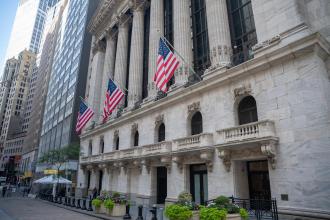The recent performance of the U.S. stock markets has been significantly influenced by two key factors: a favorable Federal Reserve interest rate cut and optimistic developments regarding a potential TikTok deal that involves dialogue between U.S. and Chinese leadership. As of September 19, 2025, the financial landscape appears brighter, with major indices such as the Dow Jones Industrial Average, the S&P 500, and the Nasdaq displaying notable gains.
On this particular day, the Dow rose by 0.3%—an increase of approximately 129 points—closing above the 46,300 mark for the first time in its history. The S&P 500 gained 0.5%, surpassing the critical 6,600 threshold to finish at around 6,669 points. The Nasdaq, known for its heavy weighting in technology stocks, climbed 0.7%, hitting new all-time highs close to 24,626 points. This positive market sentiment can be largely attributed to the Federal Reserve’s announcement of a rate cut, the first of 2025, aimed at fostering economic recovery in light of a softening labor market.
Investor confidence has been bolstered by the Fed’s decision to reduce interest rates by 25 basis points, which not only signals a move towards easier monetary policy but also suggests a commitment to support economic growth. Financial analysts and market participants view this as a strategic response to emerging economic concerns, particularly in the face of decelerating job growth.
In conjunction with these monetary policy changes, the potential TikTok deal has captured market attention. A forthcoming meeting between U.S. and Chinese leaders to discuss TikTok’s status has generated a more positive atmosphere, not just in the tech sector but across a variety of industries. The anticipation of a diplomatic resolution appears to be easing trade tensions, further amplifying investor optimism.
The technology sector has showcased significant advancements, with corporations like Apple, Tesla, and Oracle driving the market upward. Additionally, prominent tech companies such as Intel and Nvidia made headlines with Nvidia announcing a hefty $5 billion investment partnership—which in turn catalyzed substantial movement in Intel’s stock, reflecting the interconnected nature of the tech industry.
Moreover, the small-cap Russell 2000 index also reached new heights, indicative of increasing confidence in the growth prospects for smaller companies. Lower interest rates generally reduce borrowing costs, which can significantly benefit smaller corporations seeking capital for expansion and innovation.
On the commodities front, precious metals have also been on the rise, with gold prices reaching around $3,680 per ounce, marking an increase of about 1% compared to the previous day. This rise in gold prices contributes to a broader trend observed over the month, where gold has surged approximately 10%, and year-to-date, it is up about 40%. This increase can be attributed to several factors, including the Federal Reserve’s monetary easing measures and existing geopolitical uncertainties, which have reinforced gold’s allure as a safe-haven asset.
Silver has followed suit, trading near $43 per ounce following a gain of approximately 2.8% on the same day. Over the past month, silver prices have experienced a robust increase of around 13.4%, signifying strong demand tied to market risk sentiment and inflation concerns.
As investors look ahead, it is apparent that they are navigating a complex financial landscape characterized by not only market volatility but also varied economic signals. The interplay between interest rate adjustments, international trade dialogues, and the performance of key sectors will likely continue shaping market dynamics in the months to come.
In summary, the convergence of the Federal Reserve’s rate cut and diplomatic efforts surrounding TikTok has led to palpable optimism in the U.S. stock markets. The continued performance of core indices demonstrates resilience and suggests that investors are cautiously optimistic about future economic growth. The sustained gains in both major stock indices and commodities underscore a potential shift in market sentiment, driven by a carefully calibrated response to both internal and external economic pressures. The upcoming weeks will be critical in determining whether this upward trend will continue, as market participants closely monitor Federal Reserve communications, corporate earnings reports, and geopolitical developments.
Source link









